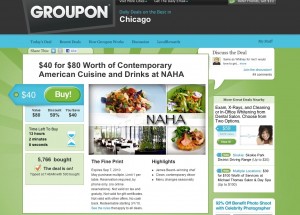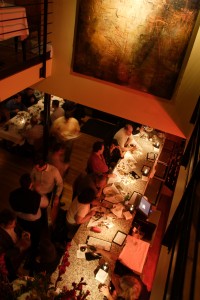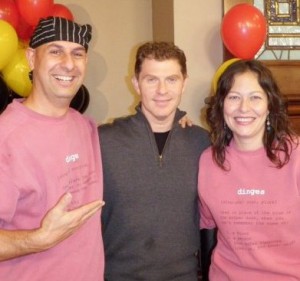 Social networking is the great equalizer. Grandmas are giving garden advice (via Facebook) to their grandchildren, stay-at-home moms in Hanover, MA are challenging college students in Hong Kong to races on Mario Kart Wii. And when it comes to the serious matter of eating out, mobile apps like Foursquare and sites such as Twitter and Facebook are revolutionizing the way we choose and patronize dining establishments. Yes, easy-to-access menus and instant reservations are part of it–but we’re talking about the most enduring lure known to man: discounts.
Social networking is the great equalizer. Grandmas are giving garden advice (via Facebook) to their grandchildren, stay-at-home moms in Hanover, MA are challenging college students in Hong Kong to races on Mario Kart Wii. And when it comes to the serious matter of eating out, mobile apps like Foursquare and sites such as Twitter and Facebook are revolutionizing the way we choose and patronize dining establishments. Yes, easy-to-access menus and instant reservations are part of it–but we’re talking about the most enduring lure known to man: discounts.
Online dining coupons have proliferated in the past two years, with companies like Groupon, OpenTable, Yelp and Blackboard Eats all vying to make a deal with restaurateurs and consumers alike. The personalization, handiness and downright techiness of these programs have left direct mail wondering where its next meal is coming from.
For the restaurant industry, this has been mostly positive, at least based on several interviews with eateries we tapped around the US.
Group-on
In late 2008 Groupon sprang from the mind of now-29-year-old Chicagoan Andrew Mason, who thought if he could get a group to commit to buying something–anything from a waffle to a spa day–the power of the group would generate the discount. He did this with the novel concept of e-mailing one coupon per day to participants.
Since its genesis, Groupon has sprung so many clones that spokesperson Julie Mossler, 28, won’t even hazard a guess. Asked how much money they’re making, she’s even more mum, but points to the fact that Forbes is currently touting their wunderkind on the cover and the article spells out that theirs is the fastest growing Web company ever. So think in very high numbers.
When asked about a recent record Gap deal, VP of marketing Mark Desky, 43, said that they “sold an unprecedented more-than-400,000 Groupons, translating into $11 million in revenue.”
Too Much of a Good Thing?
Just a whiff of what would come was good enough to attract fellow Chicagoans a couple years ago at Manny’s deli/cafeteria, which made a national splash when then-candidate Obama was known to stop by. (According to management, the president no longer visits.) Also, it didn’t hurt that Groupon representatives came in person with their pitch.
Danny Raskin, the 27-year-old manager of this long-standing family business, said of Groupon: “My experience is overall a positive one because they’re able to attract new customers [for us] that I would not have even had the opportunity to let try our food.”
Chris DeBarr, one of the chefs and co-owner with Paul Artigues of New Orleans’ Green Goddess, says he hasn’t tried Groupon and probably won’t because he found that another online discount provider “put too many butts in the tables.”

Chef Chris DeBarr's Green Goddess restaurant got more traffic than it could handle from a restaurant.com couponing program. Photo © Terri Garland
Too many butts?
“We had a fairly bad experience with Restaurant.com,” said DeBarr, 48. “It was mainly a case of our new restaurant (getting) too popular and they did not have the proper controls in place to correctly honor our limits we wanted put up on their site.”
The result, he said, was that Restaurant.com exhausted the budget in two months. DeBarr said Green Goddess wanted 30 coupons per month, but 150 were printed and the restaurant had to threaten legal action to finally stop the flow.
Restaurant.com responded:
“As he noted, we tailor our program to fit the needs of each individual restaurant and depending on those needs, can set a limit to the amount of certificates that are sold on a per day or per month basis,” said the spokesperson, who said that DeBarr would have seen traffic slow down with more time on the program.
When DeBarr signed onto the program in December 2009, wrote the spokesperson, “he agreed to a five gift certificate per day limit, which is about 150 certificates per month…[And then] once he saw an increase in traffic after a couple of months on the program, he wanted to lower the amount of certificates offered so we brought the limit down to 30 certificates per month. Because a higher amount of certificates were being sold earlier, Mr. DeBarr probably still saw a good amount of certificates come through the door that were sold prior to the limit decrease.”
Whatever the case, DeBarr is glad to have moved on and sees one positive from the experience: “We did have some great tables who discovered us from Restaurant.com…I will say they got the word out.”
He is currently considering trying Living Social and using that to give to one of his key causes, the Greater New Orleans Foundation, so as to continue supporting those affected by the Deepwater Horizon oil spill. DeBarr, not surprisingly, was one of the thousands of chefs displaced by Katrina and has used his platform as a prominent local chef–he was named “Best New Chef” by New Orleans Magazine in 2006 and put the Delachaise Hotel on the food map with his quirky cocktail menu–to support restoration.
DeBarr said the only promotion he’s sure they’ll do at Green Goddess will be “something silly we dreamed up for a local magazine, Edible New Orleans. We put a beautiful close-up photo of one of our dishes in the ad and encouraged folks to take their own pictures while dining at the Green Goddess.”
Use It or Lose It
Fifth Group Restaurants in Atlanta is on the Groupon bandwagon since they’ve enjoyed two successful runs. Part of their success was due to working out a deal with the Groupon executives that would speed up the expiration date on the coupon to 90 days. According to Groupon’s Mossler, “Most Groupons have expiration dates of six months to one year, unless it’s something time-sensitive like concert tickets or a seasonal holiday or summer feature.”
Fifth Group partner Robby Kukler, 46, said that they had their first positive Groupon experience eight months ago at their South City Kitchen in Vinings, GA (there is also one in midtown Atlanta.)
“We sold about 3,500 Groupons,” said Kukler. “The vast majority—85 to 90 percent–of our guests were first-timers. They were also fairly good spenders. The average check went up about seven to 10 percent.”
Kukler and team clearly were pleased: the Groupon users weren’t cheapskates, either, buying a nice bottle of wine or dessert to augment the $35 value of their $15 vouchers. Note: while most Grouponers are printing their coupons, those with iPhones and other smart phones can simply have a bar code read at the restaurant. Kukler said only about 10 percent of customers are doing this.
Yet, it was not sunshine and roses when Fifth Group tried a promotion with a different company.
“We did a 2-for-1 promotion in a particular zip code. The company said ‘let us do it free for a month and we’ll show you the results. It did drive people in the door, but it was not our clientele. They came in, bought two entrees, drank two waters, left and did not tip well.”
Wheeling and Dealing
Chefs come in all shapes and stripes, though, so when Wafels and Dinges’ wizard-behind-the-cart-phenom Thomas DeGeest tapped Groupon in July, he was part of not only the digital-fingers trend, but part of a truly mobile trend. His cart is positioned throughout New York’s boroughs of Manhattan and Brooklyn with occasional stops in Queens and the Bronx. Wafels and Dinges post their whereabouts each week online.
“I was very happy with [Groupon] for several reasons,” said DeGeest, 40. “First, we combined Groupon with the launch of two new products and we [designed our] Groupon [exclusively] for those two products. It was at the start of the summer. Remember, we had crazy, hot weather then, and so we wanted to make sure people understood we also offered ice cream. A lot of people didn’t know we make our own waffle cones.” The Groupon they offered worked like this: an $8 value for just $4 with the Groupon. DeGeest was guaranteed $2 from Groupon for each coupon sold, regardless of whether the buyer cashed in.
“How many thousands of people do Groupon in New York?” DeGeest asks. “Maybe 30,000 to 40,000. It’s huge.”
The second point was that Groupon got their name out, he said.
“The audience on Groupon is somewhat aligned with our audience – they are educated, IT and web savvy people. Even if they didn’t know about us, they got brand awareness through that channel,” said DeGeest.
Indeed, part of that “target audience” is decidedly younger, a point echoed by Raskin, who saw a real change in his customer demographics with the Groupon.
So as to the million dollar question: is social media killing direct mail? The answer appears to be yes.
“They [the Groupon participants who came to the cafeteria] were younger than our average customer, which was great,” says Raskin, 27.
“Obviously, the people using the Groupon are computer-savvy enough to sign up for the [coupons], [and these] are going to be younger people, 18 to 30, who use a computer (regularly). The older people are starting to catch up, though; even those in their 60s and 70s are starting [to become tech-savvy] because they’re able to afford [new technology].”
Raskin said he wants a certain kind of customer anyway, someone capable of buying an iPhone. “Our product is not a cheap product,” he said of the Manny’s menu.
What’s Next?
Chef DeBarr and team have had a very busy summer so really don’t need to tap the e-coupon craze.
“We are already far busier than we were in January and February of 2010, and summer is supposed to be our slow season. Since our menu is not designed for the everyday bargain hunter coupon clipper, [coupons] are not a good fit with our mission of adventurous cuisine and cocktails.”
So as to the million dollar question: is social media killing direct mail? The answer appears to be yes.
Kukler said his print budget is just 10 percent of what it was 10 years ago. He reaches his estimated 350,000 clients almost strictly online, via a database.
And DeBarr said although he’s a golden oldie like direct mail, he likes the current trend: “I see far fewer junk coupon offers in my mailbox lately, which I consider to be a very good sign!”


Great article on Groupon! Lots of information on a cutting edge subject. Thanks.